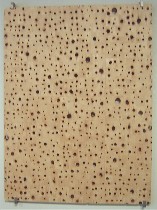 That Roberta just wrote about megaprints made me think about the tiny size of most of the pieces at “Traces,” an exhibit at Rosenwald-Wolf Gallery and the University of the Arts.
That Roberta just wrote about megaprints made me think about the tiny size of most of the pieces at “Traces,” an exhibit at Rosenwald-Wolf Gallery and the University of the Arts.
Seems to me I’ve been seeing a lot lot lot of tiny tiny tiny work. Can it be the gradiose gestures of macho art have fallen out of style? Or is it just a function of the market. Small pieces come at affordable prices.
And then there’s the function of the sort of work this is for the most part–the obsessive process pieces that are so dense in effort and concentration that larger would be unthinkable.
Which is not a slam. I liked so many of the pieces I saw in this show that I hardly know where to begin, what to include, what not to include. So I’ll start out by saying that just because I haven’t written about a piece in this show doesn’t mean I didn’t like it. But the number of pieces–nearly 50–and the number of artists–about 30–means it’s a tough show to wrap your arms around.
 For density of quality, I’d go to the lobby area, where I was happy to revisit some blackboard work by Jennie Shanker, happy to meet the block of wood from Roger Ackling, happy to find a Joseph Beuys that made me laugh and happy to see a Stuart Netsky up to his old tricks about skin (human existence?) and gay-itude.
For density of quality, I’d go to the lobby area, where I was happy to revisit some blackboard work by Jennie Shanker, happy to meet the block of wood from Roger Ackling, happy to find a Joseph Beuys that made me laugh and happy to see a Stuart Netsky up to his old tricks about skin (human existence?) and gay-itude.
Shanker’s blackboard-painted stack of little vellum rectangles (left) brought me back to the way my teacher used to hang a layered stack of student work on the bulletin board. The density of the paint, grayed to chalkiness, on the skin-like paper evoked the touch of the wooden desks, the powdery erasers, the permanent marks on boards that were washed daily but rarely came fully clean. The little stack was a tear-off tablet or a notebook, its layers the years spent as a student, the size an evocation of small children.
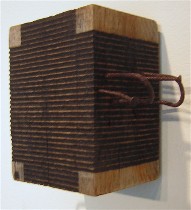 Ackling’s block of wood, “Sunlight on Wood” (right), was created with a magnifying glass training a pinpoint of sunlight on the block to brand in the lines, said Sid Sachs, gallery director there and the show curator. The process becomes all the more reason for looking at this tiny block. It evoked in me a kinetic response to the steadiness of hand and mind required. I was in awe. The Beuys piece, “Intuition,” on the other hand, was the only Joseph Beuys piece I have ever liked–a box with lines indicating the width but bearing no relationship to the box’s real width.
Ackling’s block of wood, “Sunlight on Wood” (right), was created with a magnifying glass training a pinpoint of sunlight on the block to brand in the lines, said Sid Sachs, gallery director there and the show curator. The process becomes all the more reason for looking at this tiny block. It evoked in me a kinetic response to the steadiness of hand and mind required. I was in awe. The Beuys piece, “Intuition,” on the other hand, was the only Joseph Beuys piece I have ever liked–a box with lines indicating the width but bearing no relationship to the box’s real width.
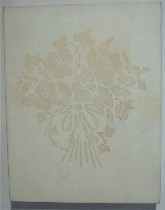 And Netsky’s “Pansy Nosegay” (left) a nosegay image made with self-tanning lotion on vellum is about a whole bunch of things, from vanity to gay culture to Victorian culture to sickness and health.
And Netsky’s “Pansy Nosegay” (left) a nosegay image made with self-tanning lotion on vellum is about a whole bunch of things, from vanity to gay culture to Victorian culture to sickness and health.
In the main room. Gabrielle Kanter’s jig-saw puzzle of wood knots pieced together had the element of surprise. At first, before the pieces become visible, “288 ft/ft” (top) looks like a piece of wood with more knots than nature could possible offer. Then the how-she-did-it becomes visible close up. And then the craftsmanship and the amount of labor come into focus.
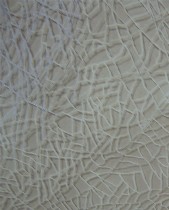 Next to it, Sharyn O’Mara’s cut paper web throwing its shadow on the paper behind it is another labor-intensive piece that wows with the energy and craftsmanship that went into the making (detail shown right). Which brings me to the subject of the show, traces of process.
Next to it, Sharyn O’Mara’s cut paper web throwing its shadow on the paper behind it is another labor-intensive piece that wows with the energy and craftsmanship that went into the making (detail shown right). Which brings me to the subject of the show, traces of process.
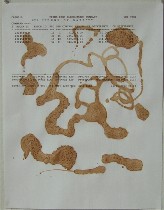 The show, said Sachs, which is part of the Big Nothing extravaganza of exhibits around the city, originally was supposed to happen back in September, but he flip-flipped it with Jack Pierson’s show because this one was such a nice fit with Big Nothing.
The show, said Sachs, which is part of the Big Nothing extravaganza of exhibits around the city, originally was supposed to happen back in September, but he flip-flipped it with Jack Pierson’s show because this one was such a nice fit with Big Nothing.
 Changing pace from the small and obsessive, I got a kick out of Perry Steindel’s soy sauce drawings (one of four shown left)and Janet Passehl’s dirt, a white piece of cloth with a small stain, displayed in an enormous vitrine as if it were precious (right). What a good commentary on painting and the art world and the business of art and reliqueries.
Changing pace from the small and obsessive, I got a kick out of Perry Steindel’s soy sauce drawings (one of four shown left)and Janet Passehl’s dirt, a white piece of cloth with a small stain, displayed in an enormous vitrine as if it were precious (right). What a good commentary on painting and the art world and the business of art and reliqueries.
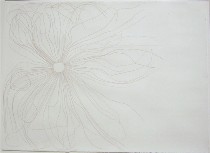 I’m going to pretty much stop here, because I know that Roberta will weigh in and also just because I feel I’m going to get repetitive about the small and the obsessive. I’m hard-pressed to say who did the work that was the most obsessive. So many candidates, like Jacob El Hanani, Kim Jones, Mark Lombardi, Paolo Columbo, Tom Chimes, Ellen Torpey, Amy Podmore’s hair drawings (right), etc. etc. etc. Much to love. The smallest work was Romy Scheroder’s “Kalipods,” which I couldn’t find without Sachs’ help.
I’m going to pretty much stop here, because I know that Roberta will weigh in and also just because I feel I’m going to get repetitive about the small and the obsessive. I’m hard-pressed to say who did the work that was the most obsessive. So many candidates, like Jacob El Hanani, Kim Jones, Mark Lombardi, Paolo Columbo, Tom Chimes, Ellen Torpey, Amy Podmore’s hair drawings (right), etc. etc. etc. Much to love. The smallest work was Romy Scheroder’s “Kalipods,” which I couldn’t find without Sachs’ help.
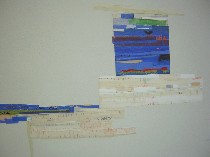 On the other hand, Anne Seidman’s wallscape, “Smart move” (detail right) was by no means little although it still bore the intensity of her mark-making practice in bits of tape bearing the traces of previous line installations she’s made. Yes, she actually saved the bits of tape. And then with these obsessive traces of her past work, she’s allowed in a dose of airiness, enormous blocks of space, the antithesis of the dense markings. Voila. I saw land and sky.
On the other hand, Anne Seidman’s wallscape, “Smart move” (detail right) was by no means little although it still bore the intensity of her mark-making practice in bits of tape bearing the traces of previous line installations she’s made. Yes, she actually saved the bits of tape. And then with these obsessive traces of her past work, she’s allowed in a dose of airiness, enormous blocks of space, the antithesis of the dense markings. Voila. I saw land and sky.









